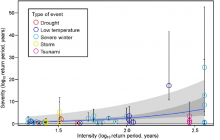Earth Sciences
News

25 May 2018
A professor, affiliated with South Korea's Ulsan National Institute of Science and Technology (UNIST) has been appointed to the new panel of the Climate Dynamics Panel (CDP).

25 May 2018
South Korea's Ulsan National Institute of Science and Technology (UNIST) celebrated the opening ceremony of the Jülich-UNIST Joint Leading Institute in Advanced Energy Research.
24 May 2018
A highly precise method to determine past typhoon occurrences from giant clam shells has been developed, with the hope of using this method to predict future cyclone activity.

23 May 2018
Nemo’s genome has been deciphered and made publicly available, helping researchers further investigate fish ecology and evolution.
23 May 2018
Rainfall simulations in statistical models could allow accurate prediction of dangerous landslides.
15 May 2018
Protein analysis could lead to new advances in DNA sequencing technologies.
10 May 2018
Low rises on the ocean floor at a depth of 5,500 meters in the western North Pacific regulate surface flows and create sharp sea surface temperature (SST) fronts, which have tremendous effects on the climate and marine resources.
07 May 2018
Color changes in the northern Red Sea indicate rising sea temperatures could significantly impact tropical marine ecosystems.
07 May 2018
An electronic tag that stretches and flexes while it records location and environmental data can monitor marine animals in their natural habitat.
07 May 2018
In the past decade after the devastated 5.12 Wenchuan Earthquake in Sichuan, academics and students from The Hong Kong Polytechnic University (PolyU) have been working on a series of inter-disciplinary projects to help enhance the resilience of the affected communities.
03 May 2018
Custom-made gas-sensing material could lead to inexpensive devices for real-time air quality analysis.
02 May 2018
Researchers at Nagoya University resolve the formation mechanism of “spherical carbonate concretions” and find they form much more rapidly than previously recognized.
25 Apr 2018
In the longest running study of its kind, researchers found sea urchin populations were strongly affected by human-driven environmental changes.
04 Apr 2018
Oil expert Tadeusz Patzek aims to ensure that efficient recovery of oil and gas remains feasible whilst scientists find alternative green energy sources.
30 Mar 2018
A new method could help scientists understand how wildlife populations are affected by major natural events, such as hurricanes, severe winters, and tsunamis.
27 Mar 2018
The College of Arts and Sciences at Qatar University (QU-CAS) held on March 26-27 its first Sustainable Development Conference aimed to highlight the efforts of the State of Qatar towards the achievement of a holistic sustainable development vision in line with the goals of Qatar National Vision 2030.
13 Mar 2018
Researchers have discovered a rule to predict an arthropod community structure based on the genomic variation in a foundation tree species.
12 Mar 2018
Unveiling new strategies to improve future wireless underwater sensing networks for marine research and communication.
12 Mar 2018
Researchers led by Nagoya University discover penetrative trace fossils from the late Ediacaran of western Mongolia, revealing earlier onset of the “agronomic revolution”.
06 Mar 2018
Understanding how bacteria help convert glacier bedrock into soil could help address desertification.

28 Feb 2018
More accurate statistical modeling of extreme weather will improve forecasting and disaster mitigation.
28 Feb 2018
Corals living in highly saline waters may be more tolerant to rising water temperatures.
22 Feb 2018
Researchers have identified the first spontaneous mutant coral symbiont alga to not maintain a symbiotic relationship with its host.
20 Feb 2018
Seagrass meadows play a pivotal role in protecting coasts against rising sea levels.
19 Feb 2018
Nitrate deposits in the Arctic remains high even after the turn of the century, despite environmental policies adopted by neighboring countries in the late 20th century to cut nitrogen oxide (NOx) emissions.
13 Feb 2018
Clonal ants appear to be diverse in responding to sweetened water, suggesting epigenetic regulation in behavioral variation and colony survival.
13 Feb 2018
Ocean colour could serve as a reliable proxy for salinity, opening the door for more frequent and detailed measurements.
09 Feb 2018
The first observational study of a dung beetle species on Langkawi Island in the Andaman Sea reveals insights about its tastes and what that means for the ecosystem.
06 Feb 2018
Multi-omics research (*1) on Thermosulfidibacter (isolated from a hydrothermal field in the Southern Okinawa Trough) has enabled the discovery of possibly the most primordial form of tricarboxylic acid (TCA) cycle.
30 Jan 2018
A method to visualize hidden statistical structure helps make sense of environmental data.
Events
Sorry, nothing coming up for this discipline
Researchers
Sorry, nothing coming up for this discipline
Giants in history
Sorry, nothing coming up for this discipline

























